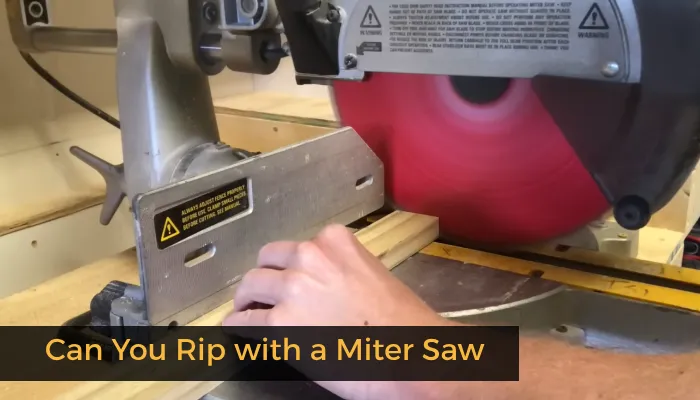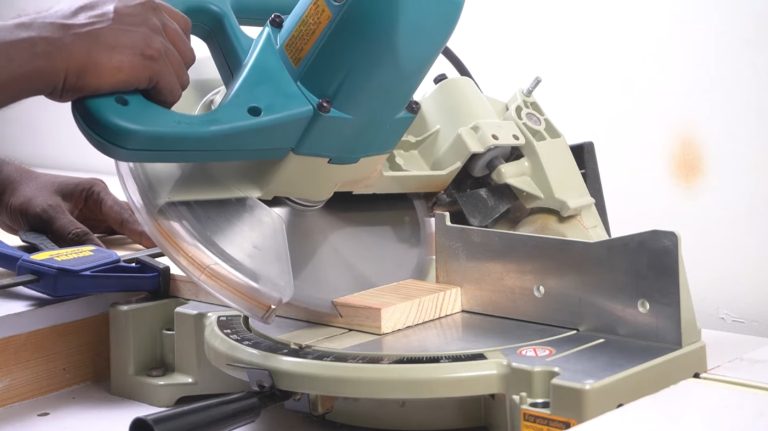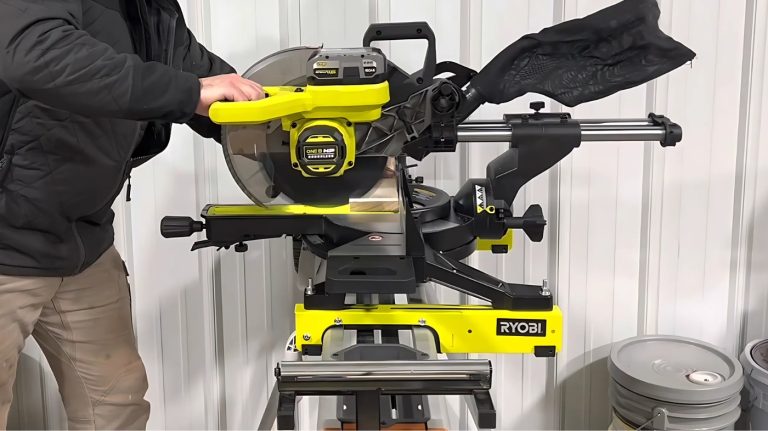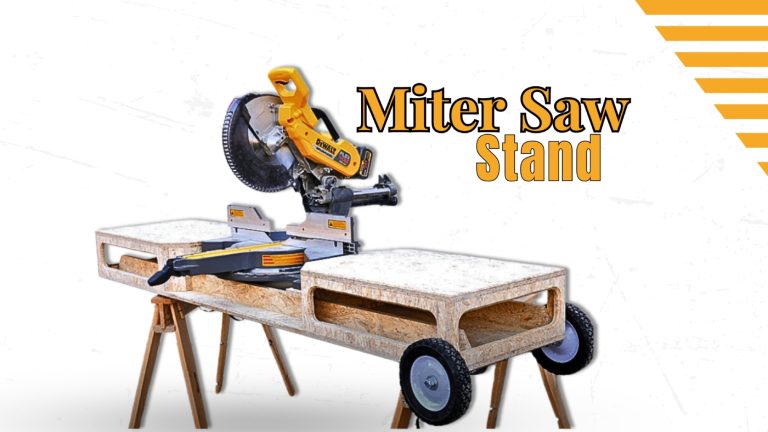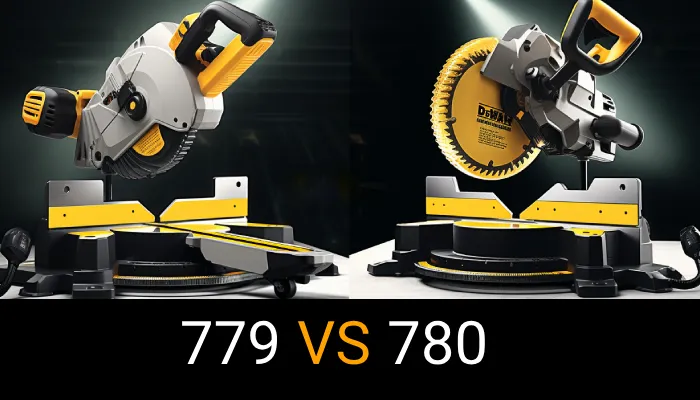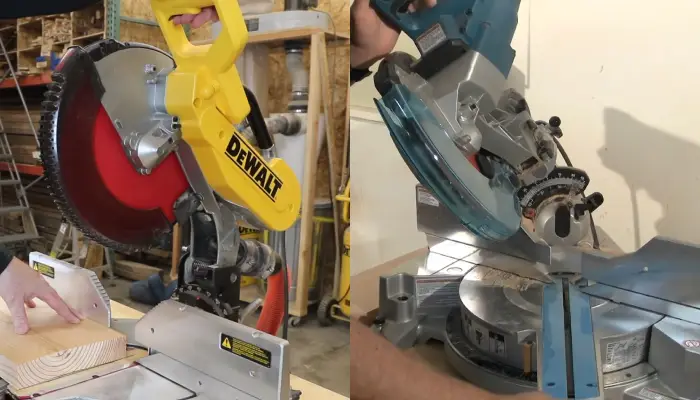Can You Rip with a Miter Saw: 6 Reasons Not to Do It
A miter saw is typically used for making precise crosscuts, miter cuts, and bevel cuts in various materials like wood, plastic, and sometimes even metal. The term “rip” usually refers to making long cuts along the length of a board, typically done using a table saw or a circular saw.
Miter saws are not designed for ripping, as they are not equipped with the necessary mechanisms and safety features for this type of operation.
Attempting to use a miter saw for ripping can be dangerous and lead to inaccurate cuts, kickbacks, and other safety hazards. If you need to make rip cuts, it’s best to use a table saw or a circular saw equipped with a guide or fence designed for ripping operations.
In this informative article, we will delve into the reasons why it is not recommended, explore potential modifications to make it possible, and discuss alternative solutions like converting the miter saw into a table saw or reinforcing its base.
Get ready to have all your questions answered and make an informed decision.
Why Should You Not Rip with a Miter Saw?
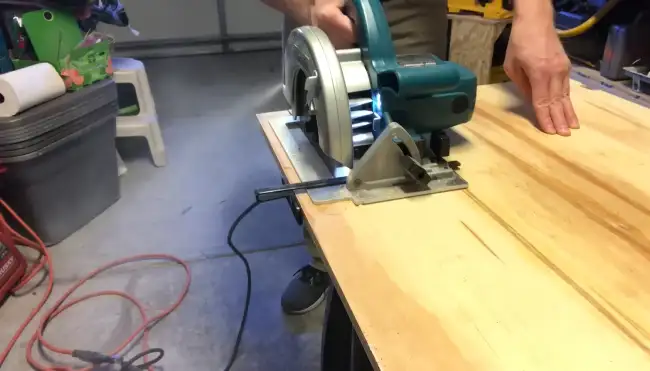
Using a miter saw may not be the best choice when ripping wood. Here are some of the reasons why you shouldn’t use a miter saw for this purpose:
- Lack of proper mechanism
- Limited blade height and fence design
- Safety concerns
- Inaccurate cuts
- Risk of damaging the tool
- Alternate tools available
Let’s check out each reason in detail.
No 01: Lack of Proper Mechanism
While using a miter saw, you can’t rip long pieces of material due to its lack of proper mechanisms. Miter saws are specifically designed for making accurate crosscuts, miter cuts, and bevel cuts, not for ripping.
Miter saws do not have a fence or a mechanism to guide the material to be ripped. This lack of proper mechanism poses a safety concern as well, as ripping long pieces of material on a miter saw can result in kickback or the material being uncontrollable.
Additionally, miter saws usually have smaller tables, making it difficult to support and stabilize long pieces of material during ripping. Therefore, using the appropriate tools, such as table saws, is highly recommended for ripping long pieces of material.
No 02: Limited Blade Height and Fence Design
To effectively cut through the thickness of a board and provide stability for ripping operations, it is necessary to use a tool with a higher blade height and a longer fence than a miter saw.
Unlike table saws, miter saws do not have a limited blade height and a shorter fence. The limited blade height means that the saw cannot cut through the entire thickness of a board, resulting in an incomplete cut.
Additionally, the shorter fence on a miter saw needs to provide the necessary stability and control for ripping operations.
Ripping requires a tool with a taller blade height to ensure a complete cut and a longer fence to support the board and maintain accurate cuts. Therefore, a miter saw is not suitable for ripping tasks and other tools should be used for this purpose.
No 03: Safety Concerns
Using a miter saw for ripping can pose significant safety risks and should be avoided due to the lack of anti-kickback features and the potential for accidents.
Ripping involves feeding a board lengthwise through the blade, which can result in kickback, where the workpiece is forcefully thrown back toward the operator.
Miter saws are not designed for this type of operation and therefore lack the necessary safety measures to handle the force generated. The limited blade height and fence design also contribute to the risk, as they do not provide the stability and control needed for ripping.
Utilizing a tool for a purpose it’s not intended for can lead to safety violations and compromise your well-being. Following safety guidelines and regulations is crucial to prevent accidents and ensure a safe working environment.
No 04: Inaccurate Cuts
The lack of a proper guide or fence can result in inaccurate cuts and compromised precision when attempting to make rip cuts with a miter saw. Miter saws are designed for making cross cuts and angles, not ripping.
Without a guide or fence to keep the workpiece in place, it can easily move off course during the cut, leading to uneven cuts and jagged edges. The precision that miter saws are known for is lost when attempting to rip with them.
The lack of a guide also makes it difficult to maintain a straight line, further contributing to the inaccuracy of the cuts.
No 05: Risk of Damaging the Tool
Ripping with a miter saw can potentially damage the tool and reduce its lifespan. The motor, blade, and other saw components are not designed to handle the strain and force that ripping tasks require. When you attempt to rip with a miter saw, you risk overloading the motor, causing it to overheat and potentially burn out.
The blade may also become damaged or dull more quickly, as it is designed for something other than the side-to-side motion required for ripping. Additionally, the saw’s fence and hold-down system may not be sturdy enough to securely hold the workpiece during a ripping cut, leading to inaccurate and unsafe cuts.
No 06: Alternate Tools Available
Another option is using a table or circular saw with proper ripping guides or fences. These tools are designed specifically for ripping and offer a safer and more efficient way to make long, straight cuts.
Here are three reasons why these alternate tools are beneficial:
- Safety: Table and circular saws with ripping guides or fences provide better stability and control, reducing the risk of accidents or injuries.
- Precision: These tools’ ripping guides or fences ensure consistent and accurate cuts, resulting in clean and professional-looking edges.
- Efficiency: With their powerful motors and specialized features, table saws and circular saws allow for quicker and easier ripping, saving you time and effort.
Can You Rip with a Miter Saw if You Modify It?
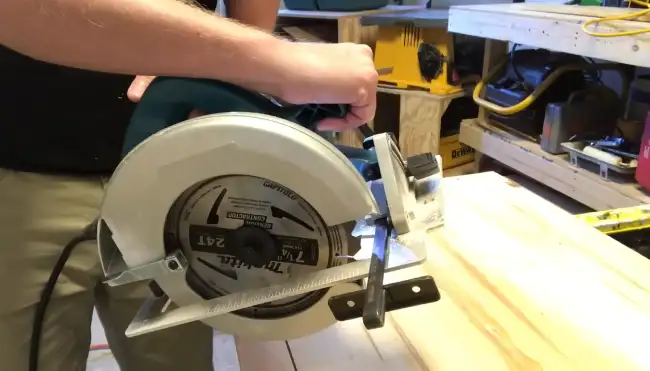
If you’re considering modifying your miter saw to enable ripping, there are a few key points to consider.
- i) Fence Extension
- ii) Rip Guides
- iii) Blade Upgrade
i) Fence Extension
To extend the fence on your miter saw for more support, you can create a longer fence that securely attaches to the existing one. This will provide additional stability and control when ripping longer workpieces. Here are three steps to follow:
- Measure and cut a piece of plywood or another sturdy material to the desired length for your extended fence.
- Attach the extended fence to the existing fence using clamps or screws, ensuring it is aligned and securely fastened.
- Make any necessary adjustments to ensure the extended fence is level and straight, using a square or level if needed.
ii) Rip Guides
Consider building a custom rip guide system for your miter saw to enhance the accuracy and stability of your cuts.
This system involves creating a long guide rail that runs parallel to the blade, ensuring a straight and precise rip.
To begin, measure the desired length of the guide rail and cut a piece of sturdy material, such as plywood, to size.
Attach the rail securely to the miter saw table using clamps or screws, ensuring it remains parallel to the blade.
Next, create a clamping system to hold the workpiece firmly in place while ripping. This could involve using adjustable clamps or a custom-made fence extension.
By implementing this custom rip guide system, you’ll have greater control over your cuts, resulting in cleaner and more accurate rips.
iii) Blade Upgrade
If you’re looking to improve your ripping capabilities with a miter saw, there is another option you can explore – upgrading the blade.
As mentioned earlier, a miter saw blade is typically designed for something other than ripping tasks. However, you can try using a rip-cutting blade with fewer teeth, specifically designed for this purpose.
By installing a blade that is optimized for ripping, you can potentially achieve better results. It’s important to note that while this upgrade may enhance your ripping abilities, it’s essential to consider the limitations of your miter saw’s motor and blade guard.
Make sure to choose a blade that is compatible with your saw and always prioritize safety when making any modifications.
Can a miter saw be converted into a table saw for ripping?
There isn’t a way to simply convert a miter saw into a table saw for ripping because the two tools are designed for different purposes. A miter saw is primarily used for making cross cuts and angled cuts, while a table saw is specifically designed for ripping long pieces of wood.
Because their designs are fundamentally different, converting a miter saw to a table saw would compromise its safety and functionality.
Converting a miter saw into a table saw would require significant alterations to the tool’s structure and mechanisms, including adding a table surface, a rip fence, and a blade guard. These modifications would not only be challenging to implement but also introduce serious safety risks.
Additionally, a miter saw needs more power and stability for ripping operations, further highlighting the incompatibility between the two tools.
Can I use a miter saw for “mini” ripping on small pieces of wood?
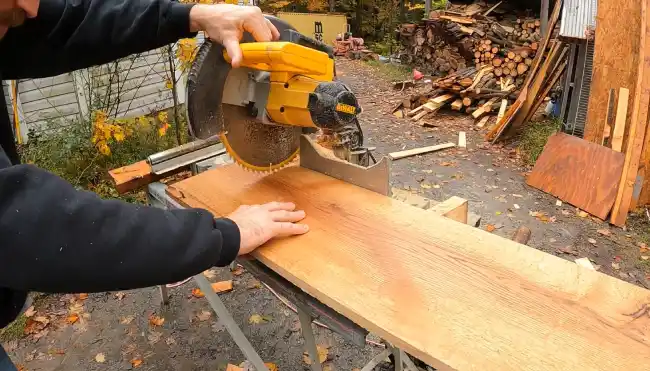
Using a miter saw for small-scale ripping on small pieces of wood can be dangerous due to the tool’s design limitations.
While it may be tempting to use a miter saw for this purpose, it is important to recognize that its design and safety features are not optimized for ripping operations.
The miter saw’s primary function is to make angled cuts, and its small size and lack of a fence or guide make it difficult to accurately and safely rip small pieces of wood.
Instead, it is advisable to use alternative tools that are specifically designed for ripping, such as a handsaw or a small rip-cutting circular saw. These tools provide better control and precision, ensuring a safer and more efficient ripping operation.
Don’t Rip with Your Miter Saw, Get a Dedicated Saw
Ripping with a miter saw is not recommended due to safety concerns and the limitations of the tool’s design. Modifying a miter saw to enable ripping is possible, but it is a complex process that should only be undertaken by experienced professionals.
While it is tempting to convert your miter saw into a table saw for ripping purposes, it is best to invest in a dedicated one for accurate and safe ripping.
However, it is worth noting that a miter saw can be used for ‘mini’ ripping on small pieces of wood with proper caution. Safety should always be the top priority when working with power tools.Stay informed and make wise choices to ensure a successful, injury-free woodworking experience.

